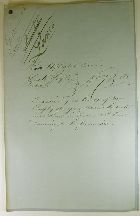Multimedia Content

Correspondence file between Brodribb Crisp & Lewis and the Town Clerk, City of Melbourne, re Coromandel Lane, 6 October 1864, courtesy of Public Record Office Victoria, Victorian Archives Centre.
Details
Coromandel Place
Coromandel Place is a dead-end laneway running north from Little Collins Street between Russell and Exhibition streets. It was named for a ship which landed at Port Phillip in July 1840 and carried 239 passengers from Plymouth in the United States. In 1860, the lane contained a French polishing business run by C. Cooper. In 1895, the lane contained Kemp and Sheehan (blacksmiths, coppersmiths, and sporting goods manufacturers). Their works were situated within a row of houses between a commercial printing works to the west, and the Eastern Arcade and Eastern Market. The lane also contained a substantial bakery and provided service access to the East Melbourne Hotel on Bourke Street. A blacksmith still operated out of Coromandel Place in 1935, but it was then surrounded by a printery, publishing company and an engineering firm. Until 1923, the City Newsboys Society also had a warehouse in the laneway. In the early twentieth century, a gramophone repairer traded alongside the print-industry shops. The laneway's entrance is more recently flanked by an apartment building to the west, and a Uniting Church to the east.
- References
- 'Central Melbourne - Lanes C-D', in Amendment C105 - CBD Laneways Review, City of Melbourne, 2007, http://www.melbourne.vic.gov.au/info.cfm?top=195&pg=3065&bp=1902&coll=8. Details
- Bate, Weston, Essential but unplanned: The story of Melbourne's lanes, State Library of Victoria and the City of Melbourne, Melbourne, 1994. Details
- MMBW Detail Plan, 1013, City of Melbourne, image no bw0004, 1895; MMBW Melbourne Sewerage Plans 1890s - 1950s; State Library of Victoria. Details
